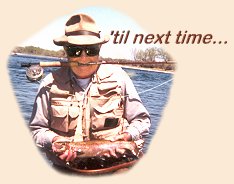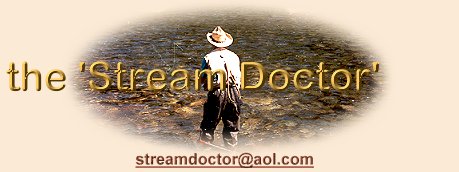Q.
From Dan in Colorado: At what water temperature do insects start hatching
and trout start to actively feed?
A.
First, the insect part of the question. Each species of insect (and
there are several thousand) requires a certain thermal history before
it hatches. Further, the thermal history may vary for the same species
in different geographical areas and other environmental factors, such
as food supply, may also influence the developmental time of the nymph
or larvae. So, you see, a definitive answer to your question is impossible.
Now that I've explained why I can't give you a good answer, I do want
to tell you something about how your question could be answered. As I
said, each species requires a certain thermal history of what temperatures
the nymphs or larvae have experienced and for how long. Thus, if a
nymph started growing for 10 days at an average water temperature of
15 degrees C, this would be 150 degree days. If this were followed
by a 15 day period when the water warmed to 17 degrees C, this
would be an additional 255 degree days and a total of 305 degree days
for this 25 day period. Now if our hypothetical species required 4500
degree days to hatch, it would need 4195 more degree days. If the
water averaged 19 degrees C the rest of the season, it would take
about 221 more days, or a total of 246 days in this particular
temperature regime. Thus, if we know the degree-day requirement of
our favorite hatch and had access to good temperature records,
we'd be able to know when to expect the hatch to start.
As for when trout start to actively feed, this, too, is difficult
to put a define number on. The problem is that optimum temperature
ranges for any activity, including feeding, can vary from species to
species and among different populations of the same species. This
is because optimum temperatures for spawning, feeding, etc. are
largely determined by the temperature to which the particular
population has been acclimated. A population of rainbows living
in a relatively warm stream or lake will have different optimal
feeding temperatures than a population acclimated to a cold
environment. In general, warmer temperatures increase metabolic
activities up to a point; then it adversely affects growth, movement,
feeding, etc.
Thus, it is virtually impossible to answer your question with any
degree of precision. I talked to a local fishery biologist to confirm
the above and he agreed with me. There are data available showing
the temperatures and ranges at which various species of trout grow
best, preferred spawning temperatures, etc., but this doesn't address your
question. Let me know (streamdoctor@aol.com) if you want to pursue
this. ~ Stream Doctor
 The 'Stream Doctor' is a retired professional stream ecologist and
author, now living in the West and spending way too much time
fly-fishing. You are invited to submit questions relating to
anything stream related directly to him for use in this Q & A Feature
at streamdoctor@aol.com.
The 'Stream Doctor' is a retired professional stream ecologist and
author, now living in the West and spending way too much time
fly-fishing. You are invited to submit questions relating to
anything stream related directly to him for use in this Q & A Feature
at streamdoctor@aol.com.
|

 The 'Stream Doctor' is a retired professional stream ecologist and
author, now living in the West and spending way too much time
fly-fishing. You are invited to submit questions relating to
anything stream related directly to him for use in this Q & A Feature
at
The 'Stream Doctor' is a retired professional stream ecologist and
author, now living in the West and spending way too much time
fly-fishing. You are invited to submit questions relating to
anything stream related directly to him for use in this Q & A Feature
at